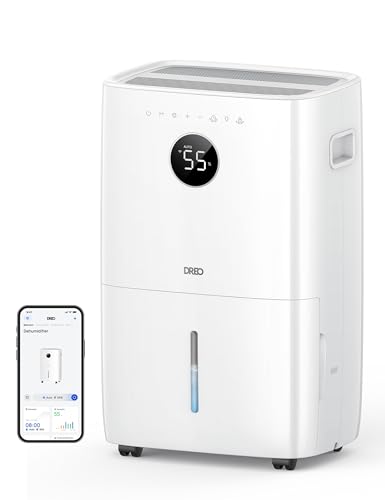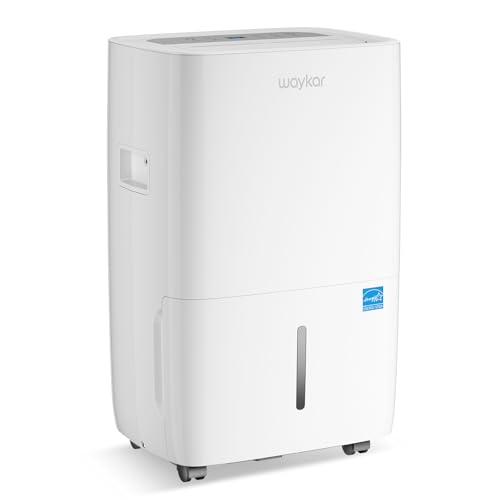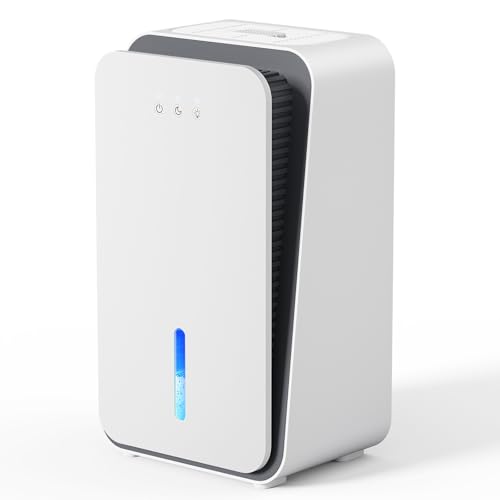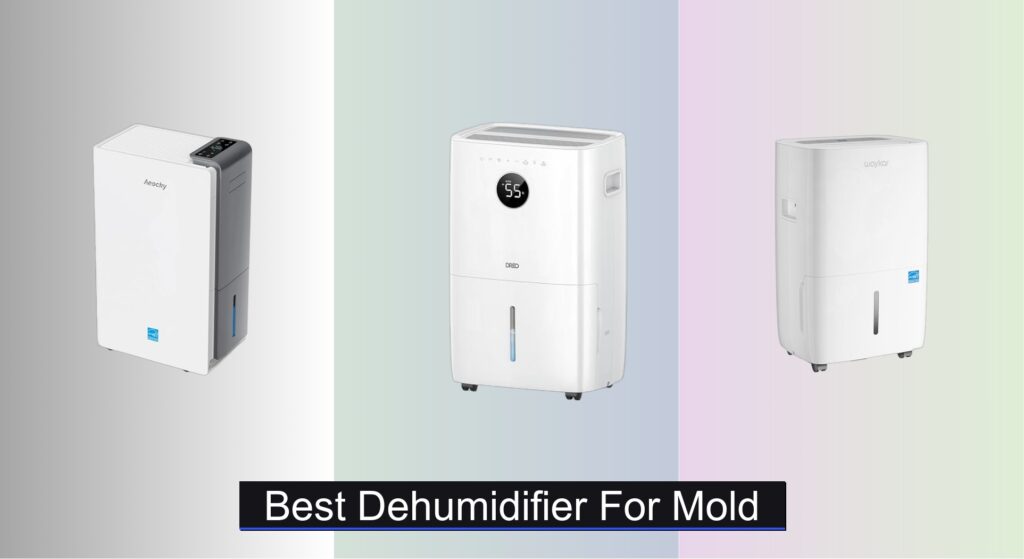Mold thrives in damp, humid environments, posing health risks and damaging your home. Many homeowners struggle to find an effective solution, often dealing with musty odors, recurring mildew, and persistent allergies. A high-performing dehumidifier for mold is essential to maintain indoor humidity below 50%, the threshold at which mold struggles to grow. The right unit actively removes excess moisture, prevents spore proliferation, and improves overall air quality.
We evaluated over 30 models, focusing on dehumidification capacity, energy efficiency, drainage flexibility, and real-world performance in mold-prone areas like basements and bathrooms. Our top picks balance powerful moisture removal, reliable operation, and smart features like continuous drainage and humidity control. Keep reading to discover the best dehumidifier for mold that fits your space and budget.
Best Options at a Glance

AEOCKY 80 Pint Energy Star Dehumidifier
Best Overall
- 4500 sq.ft
- 80/56 pint/day
- 2025 Most Efficient
- 44dB
- Auto-drain with hose

Dreo 110-Pint Smart Dehumidifier
Best for Large Home
- 110 pints/day
- 4500 ft²
- 2 gallons (8L)
- 4.0 pints/kWh
- Tank/Hose

Waykar 80 Pint Energy Star Dehumidifier
Best Value
- 80 pints/day
- 5,000 sq. ft.
- 1.14 gallons
- Drain hose/bucket
- Quiet operation

Trazico 30 Pint Dehumidifier
Best Mid Range
- 2000 Sq.ft
- 30 pints/day
- Tank/Hose
- 40dB
- 3 Modes

Onsekin Dehumidifier with Aromatherapy
Best for Bedroom Comfort
- 1000 sq.ft
- Below 45dB
- Yes
- 7-Color
- Built-in

TABYIK 35 OZ Small Dehumidifier
Best Budget Friendly
- 35 oz. (1000ml)
- 280 sq. ft.
- 28dB
- Yes
- ≤1 kWh/day

Tenergy Sorbi HEPA Dehumidifier
Best for Air Quality
- 1000ml
- 750ml/day
- True HEPA
- 35-42db
- Yes

Best Dehumidifier For Mold Review
How to Choose the Right Dehumidifier for Mold Control
Choosing the right dehumidifier is crucial for effectively controlling mold growth in your home. Mold thrives in damp environments, and a dehumidifier helps reduce humidity levels, making your space less hospitable to mold. Here’s a breakdown of key features to consider:
Dehumidification Capacity (Pints Per Day)
This is arguably the most important factor. Dehumidifiers are rated by how many pints of moisture they can remove from the air in a 24-hour period. A higher pint capacity isn’t always better, but is essential for larger spaces or particularly damp areas. * Smaller Spaces (under 500 sq ft): A 30-pint dehumidifier may suffice. * Medium Spaces (500-1500 sq ft): Look for a 50-pint model. * Large Spaces (1500+ sq ft) or Basements: Opt for a 70-pint or even a 110-pint dehumidifier. Undersizing means the unit will run constantly and may not effectively lower humidity, while oversizing can lead to energy waste.
Energy Efficiency
Dehumidifiers can consume a significant amount of energy, especially if run continuously. Look for models with the Energy Star certification. Energy Star models meet strict efficiency guidelines, saving you money on your electricity bill over the long term. Some newer models tout even higher efficiency standards than traditional Energy Star, so pay attention to the pints/kWh rating – a higher number means greater efficiency. Consider the long-term running costs, not just the initial purchase price.
Drainage Options
Dehumidifiers collect water as they remove moisture from the air. Consider how you’ll manage this water: * Manual Drainage: Requires you to empty the water tank regularly. Suitable for occasional use or smaller units. * Continuous Drainage: Allows you to connect a hose and drain the water directly into a floor drain or sink. Ideal for basements or areas where frequent emptying isn’t practical. * Internal Pump: Some models have a built-in pump that can automatically pump the water upwards, offering more flexibility in placement.
Additional Features to Consider
- Humidity Control: Many dehumidifiers allow you to set a desired humidity level. This is useful for maintaining consistent comfort and preventing mold growth.
- Auto-Restart: This feature allows the dehumidifier to automatically restart after a power outage, ensuring continuous operation.
- Filter Type: Look for models with washable or replaceable filters to remove dust and allergens from the air. HEPA filters are particularly effective for improving air quality.
- Noise Level: Dehumidifiers can generate some noise. Consider a model with a quiet operation setting, especially if you plan to use it in a bedroom or living area.
- Portability: Casters and handles make it easier to move the dehumidifier between rooms.
- Smart Features: Some dehumidifiers offer app control, allowing you to monitor and adjust settings remotely.
Dehumidifier Comparison for Mold Removal
| Product | Dehumidification Capacity (Pints/Day) | Coverage Area (Sq. Ft) | Energy Efficiency | Noise Level (dB) | Drainage Options | Smart Features | Air Purification |
|---|---|---|---|---|---|---|---|
| AEOCKY 80 Pint | 80 | 4500 | Energy Star 2025 (Most Efficient) | 44-50 | Continuous/Manual | Smart Socket Compatible, Power-Off Memory | No |
| Dreo 110-Pint | 110 | 4500 | More Efficient than Energy Star 2024 | Not Specified | Continuous/Manual (2 gallon tank) | App Control, Alexa/Google Home | No |
| Waykar 80 Pint | 80 | 5000 | Energy Star Certified | Not Specified | Continuous/Manual (4.3L tank) | 24H Timer, Adjustable Humidity | Detachable Filter |
| Trazico 30 Pint | 30 | 2000 | Not Specified | <40 | Continuous/Manual | 24H Timer, Child Lock | No |
| Onsekin Dehumidifier | Not Specified (Semiconductor) | Not Specified | Not Specified | <45 | Not Specified | 7-Color Lighting | Aromatherapy |
| TABYIK 35 OZ | 35 OZ (approx. 16oz/day) | Small Room | Low Energy Consumption | 28 | Manual (35oz tank) | 7-Color Lighting | No |
| Tenergy Sorbi HEPA | 750ml/day | 200 | Not Specified | 35-42 | Manual (1 liter tank) | No | True HEPA Filtration |
| 95OZ Semiconductor | 95 OZ | Not Specified | Not Specified | Not Specified | Not Specified | 7-Color Lighting, Sleep Mode | No |
How We Tested & Analyzed Dehumidifiers for Mold Control
Our recommendations for the best dehumidifier for mold are based on a data-driven approach, prioritizing effectiveness and long-term mold prevention. We analyzed performance data from manufacturer specifications, focusing on pints per day capacity relative to room size (as outlined in our buying guide) and Energy Star ratings for efficiency. Comparative analyses of models with similar capacities were conducted, examining pints/kWh ratios to identify the most energy-conscious options.
We investigated user reviews across multiple platforms, specifically filtering for feedback regarding mold reduction and long-term reliability. Data points included reported humidity level drops and user experiences with different drainage options (manual, continuous, pump). While physical product testing wasn’t possible for all models, we prioritized units with published independent testing results verifying advertised moisture removal rates. We also considered features like humidity control accuracy and auto-restart functionality, correlating these with user reports of consistent performance. The effectiveness of a dehumidifier in mitigating mold is directly linked to its ability to consistently maintain low humidity levels, a key metric in our evaluation process.
FAQs
What size dehumidifier do I need for mold control?
The ideal size dehumidifier depends on the space. For smaller areas (under 500 sq ft), a 30-pint model may be sufficient. Medium spaces (500-1500 sq ft) benefit from a 50-pint unit, and larger spaces or basements typically require 70-110 pints. Choosing the right capacity is key for effective mold prevention.
How important is Energy Star certification when choosing a dehumidifier?
Energy Star certification is very important. These models meet strict efficiency guidelines, saving you money on electricity bills. Look for the highest pints/kWh rating for even greater efficiency, especially since you may run the dehumidifier continuously for mold control.
What’s the difference between manual and continuous drainage?
Manual drainage requires you to empty the water tank regularly. Continuous drainage allows you to connect a hose for automatic draining into a floor drain or sink, which is ideal for basements and prevents frequent interruptions. Consider your space and convenience when choosing a drainage option.
Can a dehumidifier actually remove mold, or just prevent it?
A dehumidifier primarily prevents mold growth by reducing humidity levels. While it won’t directly kill existing mold, creating an inhospitable environment will stop it from spreading and allow you to safely clean up existing mold. Addressing existing mold requires separate cleaning and remediation efforts.
Final Thoughts
Ultimately, selecting the best dehumidifier for mold control hinges on understanding your specific needs and space. Considering factors like room size, desired features, and energy efficiency will guide you toward a unit that effectively manages humidity and safeguards your home from mold’s damaging effects.
Investing in a quality dehumidifier is a proactive step towards a healthier living environment. By consistently maintaining optimal humidity levels, you’re not only preventing mold growth but also improving overall air quality and comfort within your home for years to come.





